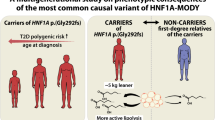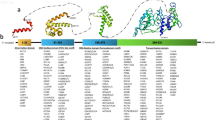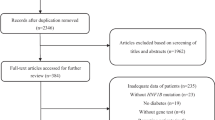Abstract
Aims
HNF1A is a gene coding for the transcription factor HNF1-α, mutated in some forms of MODY and type 2 diabetes mellitus characterized by a strong genetic component. The penetrance of HNF1A variants differs considerably; thus, to assess the genetic risk of diabetes in carrier subjects of a HNF1A mutant allele, a functional characterization of mutant forms is of paramount importance.
Methods
The HNF1A gene was sequenced in two patients with partly discordant diabetic phenotype, carrying the p.Pro409His variant. To evaluate the pathogenicity of the variant, we measured the transactivation power of the corresponding P408H HNF1-α mutant mouse form on HNF1-α target promoters.
Results
We found a lower but detectable activity of transactivation of the mutant form compared with the wild-type form and we excluded mechanisms of protein degradation or nuclear mislocalization.
Conclusions
The HNF1A mutation p.Pro409His can be considered a mild variant that confers a moderate risk of type 2 diabetes mellitus in heterozygous carriers.


Similar content being viewed by others

References
American Diabetes Association (2014) Diagnosis and classification of diabetes mellitus. Diabetes Care 37:S81–S90. https://doi.org/10.2337/dc14-S081
Vaxillaire M, Froguel P (2016) Monogenic diabetes: implementation of translational genomic research towards precision medicine. J Diabetes. https://doi.org/10.1111/1753-0407.12446
Shields BM, Hicks S, Shepherd MH et al (2010) Maturity-onset diabetes of the young (MODY): how many cases are we missing? Diabetologia 53:2504–2508. https://doi.org/10.1007/s00125-010-1799-4
Menzel R, Kaisaki PJ, Rjasanowski I, et al (1998) A low renal threshold for glucose in diabetic patients with a mutation in the hepatocyte nuclear factor-1α (HNF-1α) gene. Diabet Med 15:816–820. https://doi.org/10.1002/(SICI)1096-9136(199810)15:10%3C816::AID-DIA714%3E3.0.CO;2-P
Stride A, Vaxillaire M, Tuomi T et al (2002) The genetic abnormality in the beta cell determines the response to an oral glucose load. Diabetologia 45:427–435. https://doi.org/10.1007/s00125-001-0770-9
Althari S, Gloyn AL (2015) When is it MODY? Challenges in the interpretation of sequence variants in MODY genes. Rev Diabet Stud 12:330–348. https://doi.org/10.1900/RDS.2015.12.330
Pearson ER, Starkey BJ, Powell RJ et al (2003) Genetic cause of hyperglycaemia and response to treatment in diabetes. Lancet 362:1275–1281. https://doi.org/10.1016/S0140-6736(03)14571-0
Mendel DB, Crabtree GR (1991) HNF-1, a member of a novel class of dimerizing homeodomain proteins. J Biol Chem 266:677–680
Shih DQ, Screenan S, Munoz KN et al (2001) Loss of HNF-1alpha function in mice leads to abnormal expression of genes involved in pancreatic islet development and metabolism. Diabetes 50:2472–2480
Bjørkhaug L, Bratland A, Njølstad PR, Molven A (2005) Functional dissection of the HNF-1alpha transcription factor: a study on nuclear localization and transcriptional activation. DNA Cell Biol 24:661–669. https://doi.org/10.1089/dna.2005.24.661
Cereghini S (1996) Liver-enriched transcription factors and hepatocyte differentiation. FASEB J 10:267–282
Yamagata K (2003) Regulation of pancreatic b-cell function by the HNF transcription network: lessons from maturity-onset diabetes of the young (MODY). Endocr J 50:491–499. https://doi.org/10.1507/endocrj.50.491
Triggs-Raine BL, Kirkpatrick RD, Kelly SL et al (2002) HNF-1alpha G319S, a transactivation-deficient mutant, is associated with altered dynamics of diabetes onset in an Oji-Cree community. Proc Natl Acad Sci USA 99:4614–4619. https://doi.org/10.1073/pnas.062059799
Estrada K, Aukrust I, Bjorkhaug L et al (2014) Association of a low-frequency variant in HNF1A with type 2 diabetes in a Latino population. Jama 311:2305–2314. https://doi.org/10.1001/jama.2014.6511
Gjesing AP, Rui G, Lauenborg J et al (2017) High prevalence of diabetes-predisposing variants in MODY genes among danish women with gestational diabetes mellitus. J Endocr Soc 1:681–690
Najmi LA, Aukrust I, Flannick J et al (2017) Functional investigations of HNF1A identify rare variants as risk factors for type 2 diabetes in the general population. Diabetes 66:335–346. https://doi.org/10.2337/db16-0460
Yamagata K, Oda N, Kaisaki PJ et al (1996) Mutations in the hepatocyte nuclear factor-1[alpha] gene in maturity-onset diabetes of the young (MODY3). Nature 384:455–458
Lek M, Karczewski KJ, Minikel EV et al (2016) Analysis of protein-coding genetic variation in 60,706 humans. Nature 536:285–291
Jiang Y, Li Z, Liu Z et al (2017) mirDNMR: a gene-centered database of background de novo mutation rates in human. Nucleic Acids Res 45:D796–D803. https://doi.org/10.1093/nar/gkw1044
Mega T, Lupia M, Amodio N et al (2011) Zinc finger protein 521 antagonizes early B-cell factor 1 and modulates the B-lymphoid differentiation of primary hematopoietic progenitors. Cell Cycle 10:2129–2139. https://doi.org/10.4161/cc.10.13.16045
Bilotta A, Dattilo V, D’Agostino S et al (2017) A novel splice variant of the protein tyrosine phosphatase PTPRJ that encodes for a soluble protein involved in angiogenesis. Oncotarget. https://doi.org/10.18632/oncotarget.14350
Menniti M, Iuliano R, Föller M et al (2010) 60 kDa lysophospholipase, a New Sgk1 molecular partner involved in the regulation of ENaC. Cell Physiol Biochem 26:587–596
Bellanné-Chantelot C, Carette C, Riveline J-P et al (2008) The type and the position of HNF1A mutation modulate age at diagnosis of diabetes in patients with maturity-onset diabetes of the young (MODY)-3. Diabetes 57:503
Galan M, Garcia-Herrero CM, Azriel S et al (2011) Differential effects of HNF-1alpha mutations associated with familial young-onset diabetes on target gene regulation. Mol Med 17:256–265. https://doi.org/10.2119/molmed.2010.00097
Bjørkhaug L, Ye H, Horikawa Y et al (2000) MODY associated with two novel hepatocyte nuclear factor-1α loss-of-function mutations (P112L and Q466X). Biochem Biophys Res Commun 279:792–798. https://doi.org/10.1006/bbrc.2000.4024
Vaxillaire M, Abderrahmani A, Boutin P et al (1999) Anatomy of a homeoprotein revealed by the analysis of human MODY3 mutations. J Biol Chem 274:35639–35646. https://doi.org/10.1074/jbc.274.50.35639
Flannick J, Johansson S, Njolstad PR (2016) Common and rare forms of diabetes mellitus: towards a continuum of diabetes subtypes. Nat Rev Endocrinol Adv 12:394–406. https://doi.org/10.1038/nrendo.2016.50
Chi Y-I, Frantz JD, Oh B-C et al (2002) Diabetes mutations delineate an atypical POU domain in HNF-1α. Mol Cell 10:1129–1137. https://doi.org/10.1016/S1097-2765(02)00704-9
Kim K-A, Kang K, Chi Y-I et al (2003) Identification and functional characterization of a novel mutation of hepatocyte nuclear factor-1α gene in a Korean family with MODY3. Diabetologia 46:721–727. https://doi.org/10.1007/s00125-003-1079-7
Author information
Authors and Affiliations
Corresponding authors
Ethics declarations
Conflict of interest
All authors declare that they have no conflict of interest.
Ethical approval
All procedures performed in studies involving human participants were in accordance with the ethical standards of the institutional and/or national research committee and with the 1964 Helsinki Declaration and its later amendments or comparable ethical standards.
Informed consent
Informed consent was obtained from all patients included in the study.
Additional information
Managed by Massimo Porta.
Publisher’s Note
Springer Nature remains neutral with regard to jurisdictional claims in published maps and institutional affiliations.
Rights and permissions
About this article
Cite this article
Nocera, D., Menniti, M., Belviso, S. et al. Functional characterization of p.Pro409His variant in HNF1A, a hypomorphic mutation involved in pancreatic β-cell dysfunction. Acta Diabetol 56, 883–888 (2019). https://doi.org/10.1007/s00592-019-01298-6
Received:
Accepted:
Published:
Issue Date:
DOI: https://doi.org/10.1007/s00592-019-01298-6



